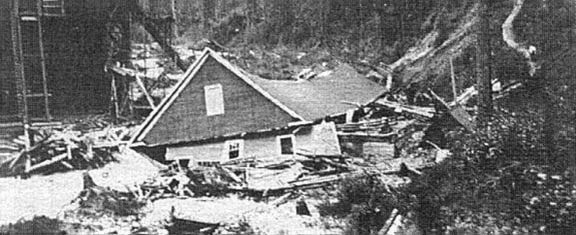"The weather the last few days has been all that could be desired, the first touch of real hot summer weather we have had so far." – Cranbrook Herald June 15, 1916
Jim Cameron
The winter of 1915-16 was a bit of a rough one in the East Kootenay. By February 10, 1916, the snowfall in Cranbrook reached a total of ten feet (three metres). Heck, even Victoria suffered a snowfall of 46.4 inches (118 cm) during the first week of the month.
The middle of February saw the weather turn to something resembling downright balmy; snow disappeared and the water ran freely. March saw a return to cool temperatures, warming somewhat in April, when it was noted that the small creek running through Cranbrook from the marsh was higher than it had been for many years.
Thus, when the "first touch of real hot of summer weather" appeared, the snow may have already been gone from Cranbrook, but the large quantity of snow still remaining in the mountains was not and by the third week of June, Cranbrook was a reasonably dry but totally isolated city.
The Elk River took out roads and railway tracks to the east, as did Moyie Lake to the west. The surging St. Mary River washed away two spans of the bridge at the St. Eugene Mission leaving it unsafe and over 1,000 sandbags were required to save the Wycliffe Bridge although it sank five feet at one end rendering it impassable.
The young communities of Marysville and Kimberley had not yet witnessed the unleashed power of Mark Creek, a fact that changed with a vengeance on June 18, 1916.
Four years earlier the Sullivan Mine by the Consolidated Mining & Smelting Co. of Canada Ltd. dammed the creek in order to provide power for both the mine and the concentrator mill; 50 feet (15 metres) long and 20 feet (6 metres) high, it proved adequate until that warm Monday in June when the structure was overpowered by the rushing waters.
Fed by recent rains and melting snow, the creek became a violent flow, altering the landscape of all it contacted beginning with the Sullivan Mine powerhouse and then undermining and destroying creek-side houses and outbuildings along its route.
Mr. and Mrs. White and their children — a four year old girl and a two year old boy — lived in Marysville, near the edge of Mark Creek.
That is to say, they lived in Marysville near the edge of Mark Creek until Monday, June 19, 1916. On that particular morning Mr. White arose at 4:30 a.m. as was his custom and discovered that they were living in Mark Creek, completely surrounded by veritable sea of raging water already beginning to wash over the floor of the house. Immediately seeking help he plunged into the stream which carried him a great distance before he could make dry land and seek assistance for his family.
Inside of an hour the majority of residents of Marysville were at the scene. All those who tried to wade to the residence were forced back by the current. Albert Hall nearly drowned while attempting to cross on a homemade raft. Mr. Keer, assisted by a number of others, hitched up his horses and headed to the St. Mary River in search of a boat as the creek rose unremittingly until, to the horror of all, the house slowly became unlodged and began to float downstream towards the falls.
The lean-to kitchen tore away in a burst of splintering chinaware and flying pots and pans as the screams of Mrs. White and the children carried across the waters.
It would have been over in a very short time had not the building jammed among some half-submerged stumps, settling with one end three feet in the water with Mrs. White holding the children on a table at the raised end of the house.
By now a boat had arrived and Messrs Lundin and Hawkes took to the water only to hit a stump and capsize. They clung to the craft until both they and the boat were hauled back ashore with ropes.
Billy Evans, a local prospector, and Provincial Police Constable Shipman took the boat 100 yards further upstream and, with 20 men managing a safety rope, headed downstream towards the house, valiantly yet ineffectively fighting the vagaries of the current.
Constable Shipman left the boat in order to position the rope around a half-submerged stump for greater control. He stood waist high in the bitter cold water while Billy and the boat jockeyed ever so slowly to the stranded family, arriving over an hour later.
As Billy disembarked and entered the precariously perched house, Constable Shipman was overpowered by the current and drawn under, only managing to save himself by clinging to a fencepost.
As Billy appeared from within the building with Mrs. White and the children a huge cheer went up from the crowd.
Still, it was a close run thing as Billy continually signaled the men on the rope to ever-so-slowly haul them against the current to safety.
It took 15 minutes to reach the stranded Constable Shipman, frigid with cold and what seemed an eternity to finally to reach men forming a human chain in the water to guide the boat to shore.
Mrs. White, the children, Billy Evans and Constable Shipman were rushed to the Central Hotel and attended to with great care.
There is no record of those involved suffering any long term effects nor any record of commendations of bravery in what must stand as one of the greatest co-operative rescues in local history.
